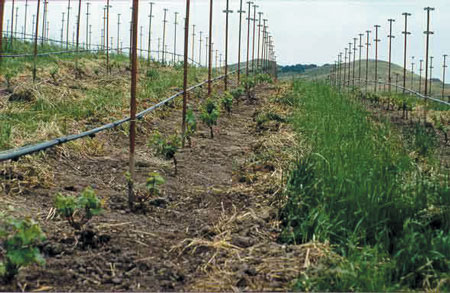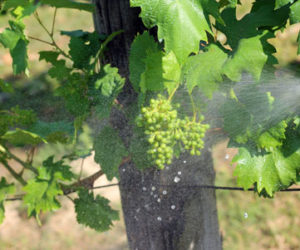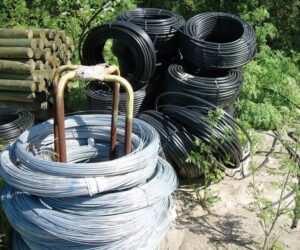Planting a vineyard takes time, effort and planning. But your work is not over once the vines are in the ground. In order to have usable grapes by your third year, you’ll need to carefully manage the growth of your vines.
First Year Goals
The first year of vine growth is meant to establish a strong and vigorous root system and build stores of nutrients to hasten growth in subsequent years. The first year of vine growth is not meant to produce fruit for winemaking. During the first year, all clusters should be removed immediately from the vine to keep the vine from using nutrients to ripen grapes. Also, the first year is not meant to push the vine into making fruit or fruiting wood in the second year, when it might not yet be ready to produce clusters. Some vines may be ready to produce fruit in the second year; others may not. The key here is patience and knowing when a vine has established itself to the point at which it is ready to make fruit for wine. In general, a vine is allowed to establish itself and grow vegetatively — producing no fruit — for the first two years in the ground. After the second full year of growth, the vine is commonly pruned by leaving a few canes on the trellis wires. These canes grow fruit in the third year.
Strong Roots
Our first goal is establishing a vigorous root system. In order to do that, the grape grower needs to water the vines, control weeds and control pests. Our second goal is to build stores of nutrients. To do that, the grape grower needs to apply the right type and amount of fertilizers to the vineyard.
Watering the Vines
As soil types and weather are different from location to location, prescribing a watering plan for all growers is difficult. The key here is providing moisture to the vines’ root system without making the soil overly muddy.
Allow the roots to dry out between water applications. This will promote root growth as the vines sink their root systems deeper into the soil layers in an attempt to find water. Vines that are “trained” to learn that their water only comes from one place (a drip emitter or a hose) will develop a root ball near the surface of the soil and will not develop a deep and wide root system. Deep, infrequent applications of water are, in my estimation, best for the vine. The vines “learn” that growing deeper in the soil profile helps them find water when the top of the soil is drying out.
Here’s a pro tip for assessing a vine’s water status: If the tendril of a vine shoot — there are usually two growing out from near the tip of the shoot — extends further than the shoot’s growing tip, the vine has all the water it needs. When the tendrils shrink back behind the growing tip, the vine is experiencing some form of water-deficit stress. Cut back the water in August or early September to help the vine go dormant (and help the shoot become a mature, wooden “cane”) before the first fall frost.
Weed Control
Weed control is absolutely vital in the vines’ early years. Once the vineyard is well established, and the vines have deep root systems, weed control will not be as critical. But, while the vines are young and their root systems shallow, they will be in direct competition with weeds for sunlight, water and nutrients. As a farmer with a strong bent toward sustainable, organic practices, I do not recommend using contact or residual herbicides in a vineyard.
It is certainly easier to lay a strip of Round-up through your vineyard instead of hoeing it. Your vines will be safer and healthier, however, if you take the time to be a farmer instead of a chemical applicator. Run a mower through the center of your rows, making a nice mulch that will feed the soil, and pay a neighbor kid to hoe the rows around the vines. Also learn that planting a cover crop rich in vetches, clover, legumes or other nitrogen-fixing plants can choke out competing weeds and add vital nutrients to your soil.
Learn which plants in your area are beneficial and which are noxious. Hoe the bad and leave the good, but make sure to clean out a strip of soil around and under the vine so it doesn’t have to compete for sunlight, water, or nutrients where it is planted and establishing itself.
Giving the vine freedom from weeds will help the roots grow faster, and as a consequence will give the root hairs more contact with the soil and the nutrients it contains.
Controlling Pests
Controlling pests, especially ones that snack on roots, is vital for the health of young vines. Fighting gophers is an ongoing battle in many viticultural regions, and — like Bill Murray in the movie “Caddyshack’” — you may well have to join the fight to assure your vineyard survives.
A vineyard is like a neatly ordered smorgasbord for a gopher. They can follow the vine row over a few weeks or months and snack on each vine in turn. All they need to do is chew around the root collar and it’s “game over” for that vine. If you see a dead vine in your vineyard, tug on it a bit. If it comes up easily with a diagonal, slightly-chewed end with no roots on it, you’ve likely been hit by gophers.
Gophers can be trapped quite easily. Or you can build a few owl-boxes in trees around your property. You will be amazed how many rodents these birds take per night. Poisoning is another option, but you need to be careful of secondary kill of household pets or other beneficial animals.
Deer, rabbits and ground squirrels can also nibble young growth in a vineyard. Fences, bait traps, dogs or a hunting permit may help with these problems. It is common to use a cut-off half-gallon paper milk carton around each young vine to keep rabbits and squirrels from nibbling young shoots. Grow tubes also discourage nibbling.
Fertilizer Application
The application of fertilizers is usually necessary in a vine’s first year to help build stores of nutrients, especially nitrogen, in the developing trunk and root system. You have two ways to do this: applying petroleum-based fertilizers or using organic fertilizers. Both will work well to help establish the vine. Using a half-cup of calcium nitrate (15-0-0) per vine a few times during the vine’s first year will definitely make the vine grow faster and remain nice and green. There are also small fertilizer packs that you can toss in the hole under the roots when planting. They are made to last about a year and slowly release nutrients to the vine. Using these petroleum-based fertilizers will have no short-term negative impact on the vines; in fact, they will grow to be very green, vigorous and healthy.
However, I call calcium nitrate “root crack” because I believe a vine can become dependent on non-organic fertilizers, like addictive drugs, and will be less likely to be happy throughout their lives without frequent applications.
Organic sources of nitrogen such as chicken manure, cow manure, fish emulsion, kelp extract, bat guano and others build the soil and increase biological activity in the soil while they provide nutrients. The nutrients that organic fertilizers provide might be more expensive per application, but the benefits they provide the soil and the holistic health of the vineyard as a living system are invaluable. Providing a healthy habitat for your vines to live in will help them grow quickly, stave off disease and provide healthy fruit for making wine in years to come.
Training the Vines
We can now return to your young vineyard, where the soil mounds are removed and two to four little green shoots are emerging from each vine. When the tallest shoot is about 6–10 inches long, it’s time to start training that shoot up the training stake. If you planted each vine close to the training stake, it will not be a difficult task to start training the vine to the stake. Always use the most vertically oriented, vigorous shoot for training. It is also vitally important to leave the other shoots growing on the vine until the most vigorous shoot has been successfully tied to the stake with 1/2” green vinyl tie-tape. This is important because you will break a few shoots during this process, and you always want a back-up shoot in case this happens.
After the most vigorous shoot has been loosely tied to the stake with tie-tape without breakage, then you can go ahead and rub off all other growing shoots and swelling buds on the vine with your thumb. Lash 1/2” tie-tape every four to six inches (10–15 cm) of growing shoot, and make a pass through the vineyard every week or so and add tie tape as necessary. Tie the tape loosely enough to stick your finger in between the shoot and the tape so it doesn’t strangle the poor little vine.
The straighter you tie the growing shoot to the stake, the more uniform and upright the trunks of your mature vines will be. If the growing shoot reaches the fruiting wire at the top of the training stake, snip off the top off the vine to promote growth out of lateral buds on the sides of the shoot. This will help the vine start to make a “head” that will produce your fruiting wood from year to year.
If the vine fails to reach the fruiting wire — or the top of the training stake, or at least 36” of growth — in its first year, I recommend cutting the vine back all the way so it looks like it did when it was first planted (one two-bud spur). Do this to all stunted vines, and to any vines that need more vigor.
Cutting all the wood off a stunted vine allows the vine to grow easier the next year. You will likely get more vigor and health from the vine if you cut it back and give it time. If your vineyard shows low vigor, it is recommended that you cut the entire vineyard back to two-bud spurs and train the future trunks in the second year of vine growth. Watch your young vines (especially the leaves) for signs of powdery mildew. Make sure to apply sulfur, wettable or powder, to keep the vines and vineyard clean of mildew. If mildew becomes established in the first year, it will be more difficult to manage in subsequent vintages. Your hard work in the first year will pay off at your first harvest.








